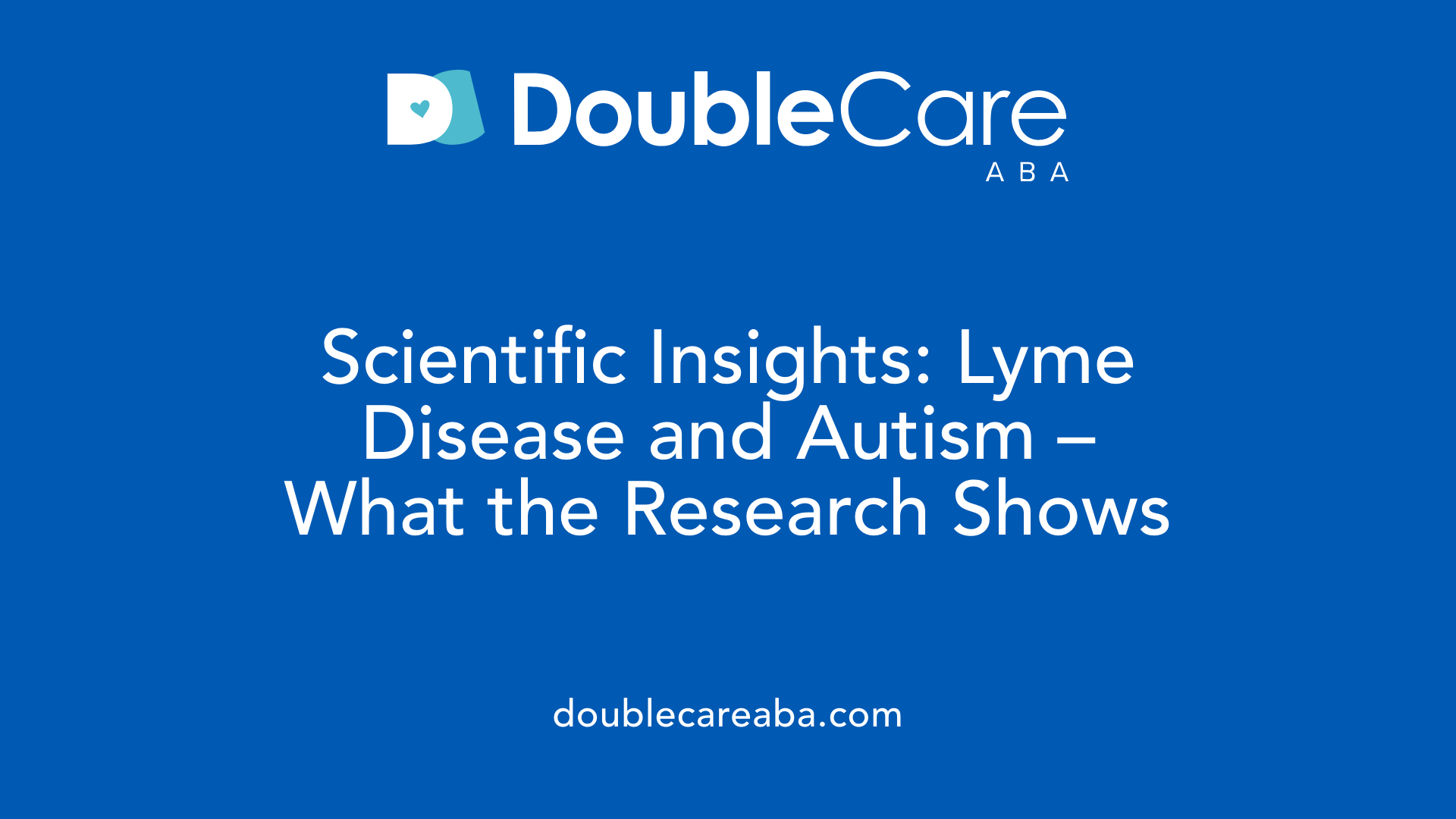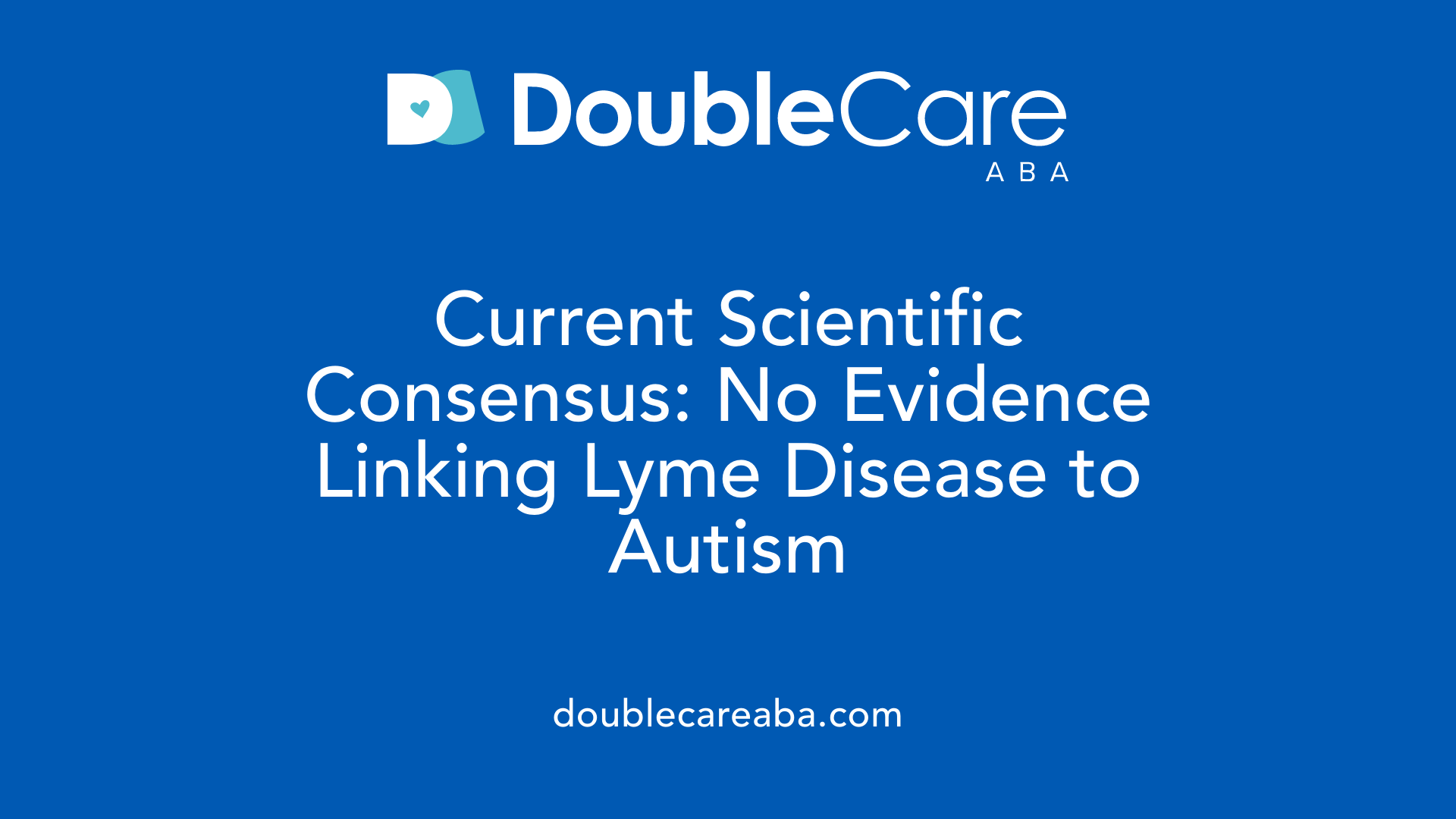Can Lyme Disease Cause Autism?
Exploring the Potential Link Between Lyme Disease and Autism Spectrum Disorder

Understanding the Overlap and Investigating the Evidence
The question of whether Lyme disease can cause autism spectrum disorder (ASD) has garnered attention within the medical community, researchers, and concerned parents. While autism is primarily viewed as a neurodevelopmental condition with strong genetic roots, some suggest that infectious agents like Lyme disease, caused by the bacteria Borrelia burgdorferi, might play a contributory role. This article delves into the scientific research, symptom overlap, and the current consensus on the complex relationship — or lack thereof — between Lyme disease and autism.
Biological Overlap and Symptom Similarities
What neurological signs are common in both Lyme disease and autism spectrum disorder (ASD)?
Lyme disease and autism often share overlapping neurological symptoms that can complicate diagnosis. In Lyme disease, neurological signs include headaches, dizziness, facial palsy, and cognitive difficulties such as memory and concentration problems. Similarly, children with ASD frequently exhibit sensory hypersensitivities, coordination issues, and sometimes seizures, which are signs of nervous system involvement.
These similarities arise because both conditions can affect brain function and development. Some individuals with Lyme disease report neurological symptoms resembling those seen in ASD, such as difficulty with sensory processing and motor coordination.
Which psychological behaviors are observed in both conditions?
Psychological behaviors are another area of overlap. Both Lyme disease and autism can lead to increased irritability, anxiety, and mood disturbances. In Lyme disease, neuropsychiatric symptoms like paranoia, depression, and obsessive-compulsive behaviors have been documented, especially in chronic cases.
In children with ASD, behavioral issues such as tantrums, hyperactivity, and social withdrawal are common. Both conditions may also involve challenges with communication, emotional regulation, and heightened sensitivities to environmental stimuli.
This symptom overlap suggests that infections such as Lyme disease may influence behavioral patterns seen in autism, although definitive causative links remain unproven.
What physical health problems are associated with Lyme disease and autism?
Physical health issues frequently observed in both conditions include gastrointestinal problems, muscle and joint pain, and immune dysregulation. Individuals with Lyme disease often report joint swelling, fatigue, and widespread musculoskeletal pain.
Autistic children similarly experience gastrointestinal disturbances, including constipation, diarrhea, and abdominal pain, which have been linked to immune system irregularities and gut-brain axis disruptions.
The immune dysregulation common to both conditions may predispose affected individuals to recurrent infections and inflammatory responses.
How does gut health intersect with Lyme disease and ASD?
Gut health plays a crucial role in both Lyme disease and autism. Dysbiosis, or imbalance of gut microbiota, has been observed in autistic children, correlating with severity of behavioral symptoms.
For Lyme disease, supporting gut health through nutritional strategies can aid in recovery. Diets that eliminate gluten, dairy, sugar, processed foods, and casein help reduce inflammation and improve immune function.
In both cases, nourishing the gut with probiotics, fiber, and anti-inflammatory foods can promote healing and possibly reduce symptoms linked to gut-brain interactions.
| Aspect | Lyme Disease | Autism Spectrum Disorder | Additional Notes |
|---|---|---|---|
| Neurological Signs | Headaches, dizziness, cognitive issues | Sensory hypersensitivity, coordination issues | Both involve nervous system effects |
| Psychological Behaviors | Anxiety, paranoia, depression | Behavioral irritability, social withdrawal | Overlapping mood and behavioral issues |
| Physical Health Issues | Joint pain, fatigue, immune problems | GI disturbances, immune dysregulation | Common systemic symptoms |
| Gut Health | Dysbiosis, inflammation | Gut microbiota imbalance | Diet and probiotic interventions support recovery |
Symptoms and Behavioral Overlap between Lyme Disease and ASD

What are the potential symptoms and behavioral similarities between Lyme Disease and autism spectrum disorder?
Lyme disease and autism spectrum disorder (ASD) share several overlapping neurological, psychological, physical, and gut health symptoms. Individuals with either condition may experience communication difficulties, sensory sensitivities, and irritability.
Neurological signs such as muscle weakness, fatigue, and neurological pain are common in Lyme disease, while ASD often presents with challenges in social interactions, repetitive behaviors, and sensory processing issues. Both conditions can lead to heightened anxiety and mood fluctuations, contributing to behavioral changes that can be difficult to differentiate.
Physical health issues like joint pain and muscle aches often occur in Lyme disease, whereas gastrointestinal problems, including constipation, diarrhea, and food sensitivities, are prominent in ASD. This overlap in gut health symptoms suggests that immune responses affecting the gut may be a shared feature.
Immune dysregulation appears in both conditions, with inflammatory responses and immune system abnormalities observed in many individuals. Brain imaging studies reveal similar patterns, notably in the temporal lobes and white matter, indicating possible neurological links.
Research exploring the role of infections like Borrelia burgdorferi in some individuals with ASD points to a potential infectious contribution. Maternal infections during pregnancy, including those caused by tick-borne diseases, may impact fetal neurodevelopment and increase the risk of autism.
Moreover, inflammatory and immune responses triggered by Lyme disease and associated coinfections could interfere with neural development, resulting in symptoms characteristic of ASD. Although current evidence supports some biological intersections, it remains complex, with no definitive causative link established.
While Lyme disease can mimic or exacerbate certain ASD symptoms, the relationship is likely multifaceted and involves immune and neurological pathways. Continued research is essential to better understand these overlaps and to develop targeted treatments.
| Symptom/Feature | Lyme Disease | Autism Spectrum Disorder | Commonalities and Notes |
|---|---|---|---|
| Neurological Signs | Muscle weakness, fatigue, nerve pain | Communication, social challenges | Both involve neurological dysfunctions; brain imaging shows similarities |
| Sensory Sensitivities | Heightened sensory responses | Sensory processing issues | Overlapping sensory sensitivities can influence behavior |
| Irritability and Behavior Changes | Mood swings, irritability | Anxiety, repetitive behaviors | Behavioral overlaps complicate diagnosis and understanding |
| Gut and Physical Health Issues | Gastrointestinal problems, pain | Digestive issues common in ASD | Gut health disruptions are common in both conditions |
| Immune System Dysregulation | Inflammation, immune activation | Immune anomalies observed | Immune pathways may contribute to symptom overlap |
| Brain Imaging Findings | Temporal lobe and white matter changes | Similar findings in studies | Imaging studies suggest common neurological substrates |
In sum, while Lyme disease can produce symptoms that resemble those seen in ASD, current evidence points to a complex interplay of immune, neurological, and possibly infectious factors. Recognizing these overlaps can aid in more accurate diagnoses and appropriate treatments, emphasizing the importance of further research into infectious influences on neurodevelopment.
The Evidence from Scientific Studies and Clinical Data

serological testing and diagnosis
Diagnosing Lyme disease relies heavily on clinical signs and symptoms since current laboratory tests have limitations. Blood tests such as ELISA and Western Blot are used to detect antibodies against Borrelia burgdorferi, the bacteria responsible for Lyme disease. However, these tests are not highly sensitive, meaning they may fail to detect active infection or may produce false positives due to cross-reactivity. A positive serology indicates exposure but does not confirm active infection, especially when based on non-standard interpretations. The CDC recommends a two-tier testing system for better accuracy, yet even these results require clinical correlation.
prevalence data and correlation studies
Epidemiological data show no significant association between Lyme disease and autism. Autism spectrum disorder (ASD) typically manifests at an earlier age than the onset of Lyme disease symptoms. Additionally, autistic children are not significantly more likely to have been exposed to ticks than their peers. Large-scale studies and reviews by organizations such as the NIH and the Autism Science Foundation have found no evidence supporting a link. The correlation coefficients between autism and Lyme disease prevalence are far from indicating a meaningful connection.
research findings on Lyme-autism link
Recent controlled research has challenged claims that Lyme disease causes autism. For instance, a notable 2019 study used the CDC-recommended 2-tier testing system in a well-defined cohort of children with autism. It found no evidence of active or ongoing Lyme disease. Many earlier claims, such as those suggesting autistic children uniquely show more Borrelia-specific bands without seropositivity, have not been supported by further peer-reviewed research. Multiple independent studies have confirmed these findings, indicating that the presence of infection does not imply causality.
case reports and treatment outcomes
While most scientific data do not establish a direct link, some case reports describe children with autism who showed improvements after antibiotic treatment targeting tick-borne infections. For example, a case recently documented involved a child with ASD and evidence of Lyme disease and co-infections, who experienced symptom relief following antibiotics. These cases suggest that in certain instances, infections might influence some behavioral or neurological symptoms, but these outcomes are anecdotal and require systematic investigation.
| Aspect | Findings | Additional Notes |
|---|---|---|
| Serological testing | Often inconclusive on its own | False positives/negatives common |
| Prevalence correlation | No significant association found | Autism onset precedes Lyme symptoms |
| Research studies | No evidence supporting causation | Large, controlled studies disconfirm claims |
| Treatment case reports | Symptom improvement in some cases | Anecdotal, not universally applicable |
Overall, current research emphasizes that while overlapping symptoms exist, there is no definitive proof that Lyme disease causes autism. The scientific consensus underscores the importance of comprehensive assessment, avoiding unproven treatments, and focusing on evidence-based strategies for managing autism.
The Scientific Consensus and Public Perception

What is the current scientific consensus on the connection between Lyme disease and autism?
The prevailing scientific view is that there is no credible evidence to suggest a direct link between Lyme disease and autism spectrum disorder (ASD). Multiple extensive studies and investigations conducted by reputable health organizations have consistently found no association between the two conditions. Major institutions like the Centers for Disease Control and Prevention (CDC), National Institutes of Health (NIH), and Autism Science Foundation have reviewed available data and concluded that Lyme disease does not cause or contribute to autism.
Research efforts have included serological testing of autistic children using the CDC-recommended two-tier system, which is designed to accurately identify active infections. These studies reveal that most children diagnosed with ASD do not show signs of ongoing or past Lyme disease infection. Findings indicating the presence of certain antibodies or bacteria in some autistic individuals are often due to cross-reactivity or past, resolved infections rather than ongoing disease.
Furthermore, the prevalence data show no significant correlation between Lyme disease and autism rates across different geographic regions. The typical age of onset for autism is much earlier than when Lyme disease symptoms tend to appear, and children with autism are not more exposed to tick habitats than neurotypical children.
Major health and autism research organizations have reviewed the scientific literature and found no supportive evidence for a causal relationship. Claims proposing extended antibiotic therapies or linking Lyme bacteria directly to autism based on unpublished or methodologically flawed studies are widely regarded as unsubstantiated and potentially harmful.
In summary, current consensus emphasizes that autism primarily results from genetic factors, environmental influences during early development, and complex neurodevelopmental processes unrelated to Lyme disease. Further research continues to explore the various causes of autism, but the hypothesis of a straightforward causal link with Lyme disease remains unsupported.
Misconceptions and Future Directions
Is there a common misconception that Lyme disease can cause autism spectrum disorder?
There is a widespread misconception that Lyme disease, a bacterial infection transmitted through tick bites, can cause autism spectrum disorder (ASD). Some organizations and individuals have proposed that infections like Borrelia burgdorferi might contribute to neurodevelopmental issues characteristic of autism. This hypothesis stems from observations of symptom overlaps such as irritability, sensory sensitivities, gastrointestinal problems, and immune system irregularities, which are common in both conditions.
Research studies have explored this potential link, with some indicating that a subset of children with ASD tests positive for markers of Borrelia infection. Notably, up to 25% of children with ASD have shown evidence of exposure to Lyme bacteria, and many of these also exhibit co-infections like Mycoplasma or Bartonella. Furthermore, some cases report symptom improvement following antibiotic treatments aimed at bacterial infections, fueling speculation about causality.
However, the scientific community generally concurs that this connection is not conclusively proven. Large, well-designed studies have failed to establish a direct cause-and-effect relationship. The majority of reputable organizations, including the NIH and Autism Science Foundation, state there is no solid evidence linking Lyme disease to the development of autism.
Additional factors complicate the narrative. Blood tests for Lyme disease, such as ELISA and Western Blot, are not always definitive, especially without clinical symptoms of active infection. False positives and cross-reactivity can occur, making it difficult to draw firm conclusions. The reviewed studies often lack peer-reviewed publication and independent verification, further muddying the waters.
While the hypothesis remains intriguing and warrants further investigation, current evidence indicates that autism likely results from a complex interplay of genetic and environmental factors, rather than a single infectious cause like Lyme disease. Future research should focus on understanding these factors more comprehensively rather than relying on unproven claims.
Unproven treatments linking Lyme disease and autism are deemed irresponsible and potentially harmful.
Many unverified treatments have emerged promoting the idea that treating Lyme disease can resolve or improve autism symptoms. These treatments often include lengthy antibiotic courses and herbal therapies. Despite anecdotal reports, these approaches lack rigorous scientific validation and may pose health risks.
Organizations focused on autism and infectious diseases warn against such practices, emphasizing that these interventions are unproven, potentially dangerous, and could delay evidence-based treatments. Without proper diagnosis, intervention, and scientific backing, these therapies are considered irresponsible.
Need for further research
The current scientific landscape underscores a need for more thorough, methodologically sound studies investigating possible infectious contributions to ASD. Future research should aim to clarify whether early infections or prenatal exposure to tick-borne pathogens influence neurodevelopment and whether targeted treatments could prevent or mitigate ASD.
Advanced diagnostics, longitudinal studies, and controlled clinical trials are essential to separate myth from fact. Only through rigorous scientific inquiry can the true nature of any association be understood, leading to better prevention, diagnosis, and treatment options for children affected by ASD.
| Aspect | Current Understanding | Future Considerations |
|---|---|---|
| Evidence of Lyme's role | Suggestive but inconclusive | Need for large-scale, peer-reviewed studies |
| Diagnostic challenges | False positives possible | Develop more specific, sensitive testing |
| Treatment approaches | Antibiotics and herbal therapies under study | Rigorous trials to assess safety and effectiveness |
| Impact of infections | Possible contribution but not confirmed | Investigate mechanisms and pathways |
| Official stance | No confirmed causal link | Continue research to clarify potential links |
This ongoing debate highlights the importance of cautious interpretation of preliminary findings and highlights the value of scientific rigor in addressing complex issues such as ASD and infections.
The Current Understanding and Looking Ahead
While the notion that Lyme disease directly causes autism remains unsupported by rigorous scientific evidence, ongoing research continues to explore the complex interactions between infections, immune responses, and neurodevelopment. Overlapping symptoms and preliminary findings highlight the importance of further studies, especially into early detection and maternal health, to better understand potential environmental and infectious contributions to autism. Healthcare providers are encouraged to adopt an evidence-based approach, focusing on accurate diagnosis and effective treatments for both Lyme disease and autism, while remaining cautious of unproven claims. Ultimately, the current scientific consensus underscores that autism is primarily genetic and multifactorial, with no confirmed causative role of Lyme disease—yet, the topic warrants continued investigation to uncover all possible contributing factors.
References
- Lyme and Autism - The Autism Community in Action
- Does Lyme disease induce autism in children
- Autism and Lyme Disease—Reply - PMC
- Is there a connection between autistic spectrum disorders and tick ...
- The association between tick-borne infections, Lyme borreliosis and ...
- Lyme and Autism - The Autism Community in Action
- Is there a connection between autistic spectrum disorders and tick ...
- The association between tick-borne infections, Lyme borreliosis and ...
- Dig Deeper - Autism Spectrum Disorder and Infectious Diseases
- The association between tick-borne infections, Lyme borreliosis and ...
















